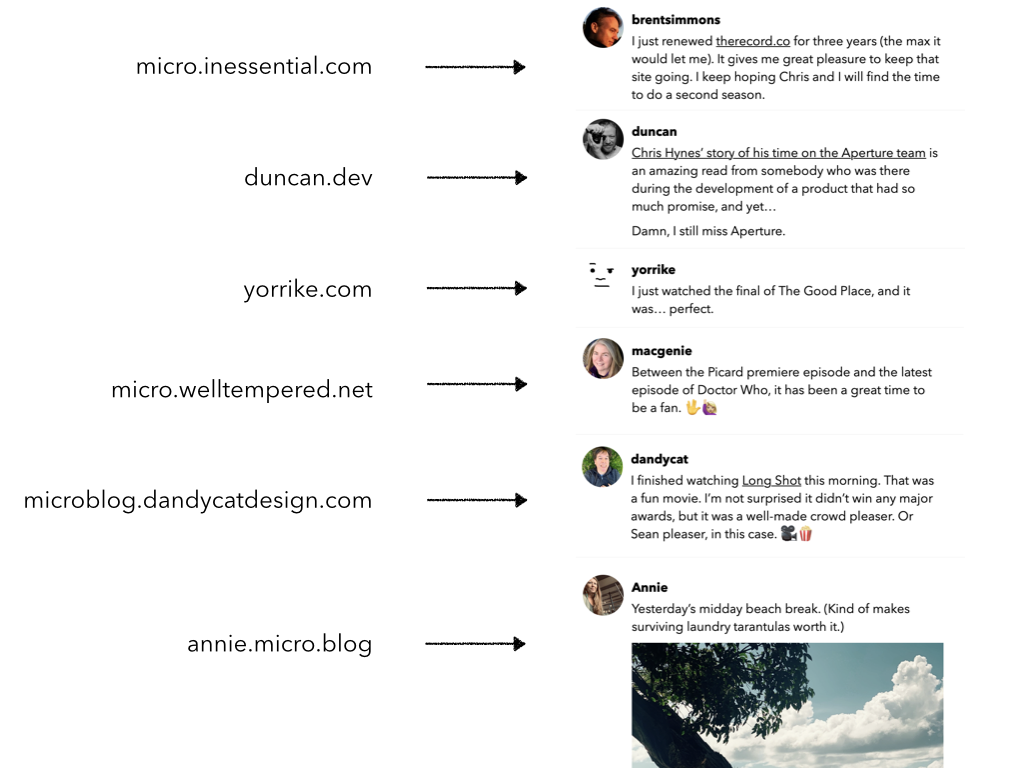What is microblogging?
“The most valuable of all talents is that of never using two words when one will do.” — Thomas Jefferson
In her 2002 book The Weblog Handbook, Rebecca Blood introduced readers to the growing niche of web sites that focused on chronological posts. She wrote about what made a blog different:
No one wants to scroll down to the bottom of the page (or even the current day’s section) to see if any new content has been posted. With new content at the top, a visitor can see at a glance whether your page has been updated and easily begin reading your latest entries without any additional effort.
Spelling it out seems obvious today. We can similarly outline what microblogging is in a way that hopefully will be obvious years from now when indie microblogging is more common.
We can approach defining the term micro logging from two sides: specific rules for feeds and platforms, and high level goals, the spirit of indie microblogging that all blogs can share even when the details vary.
Wikipedia defines microblogging this way:
Microblogging is a broadcast medium that exists in the form of blogging. A microblog differs from a traditional blog in that its content is typically smaller in both actual and aggregated file size.
But that’s not quite specific enough. A microblog post should have these qualities:
- Should have a feed, usually RSS or JSON Feed
- Does not have an RSS item title.
- Contains short post text, usually 280 characters or less.
Not having an RSS item title might take some getting used to for mainstream blogging clients and readers. Most RSS apps assume that all posts have a title, even though titles are technically optional in the spec. But I think this is an important distinction because if you think about Twitter-like posting, it should be fast and convenient; making up a title first interrupts the flow of posting.
The specific rule for post length or which feeds you include can be useful. These should be thought of as more of a guideline than a rule, though — just something to shoot for.
We focus on microblogging because it’s the easiest form of web publishing. Centralized services like Twitter and Facebook took off because they had better, simpler interfaces.
If you stop reading after this page, here’s what you need to know:
- Publish short posts and photos to your own web site, at your own personal domain name.
- Make sure your web site has an RSS or JSON feed, and add it to communities like Micro.blog.
- If you want to participate in larger social networks, post to your own site first and then copy the post to Twitter, Facebook, or Instagram.
- Massive centralized platforms create problems for society. By posting to your own site, you control your content, distributing it more evenly across the web and minimizing the power of big tech companies.
This might seem like too much work for most people. With many of today’s blogging tools, it is. We must work simultaneously on open standards and on making software that follows those standards as easy to use as possible for everyone.
What we don’t want to do is reinvent the wheel with a new social media-like protocol that isn’t rooted in the web and blogs. Others have tried to come up with new systems for microblogging that don’t use blogs. But the word “blog” is part of “microblog” for a reason. They differ only in length. By using blogs, we get to keep everything that is valuable about blogging. We get to keep existing blog software and IndieWeb-friendly formats.
Blogs are web sites with reverse-chronological posts written by people. The newest posts are always at the top of the web site. They can be news sites, corporate sites, travel sites, photo sites, tech sites. They are often personal, with an individual’s voice. Readers want to keep visiting a blog because there’s a story, unfolding with each post. The passing of time is a fundamental element to what defines a blog.
This emphasis on time is even more obvious for microblogs. Microblogs are blogs with very short posts. Because short posts are easy to write, there are usually more of them. In the case of a microblogging service like Twitter or Micro.blog, friends' posts are combined together in a timeline.
In an open platform based on indie microblogs, posts in the timeline come from blogs at the author’s own domain name. This helps distribute content across the web and bypasses the bottleneck of posting only through big social networks, reducing their influence:

Recent posts are placed at the top of the timeline. Older posts fall to the bottom, and eventually drop off. With this focus on the new, some people consider microblogging ephemeral, but it doesn’t have to be.
Indie microblogging is about taking ownership of our microblog post content. It’s about reclaiming the definition of what a microblog is from Twitter. Microblogs and social networks are big components of the web — too important to be contained in such a small number of closed, centralized platforms.
An indie microblog is a blog that contains short posts at your own domain name. It can be hosted by multiple providers, but it is conceptually independent of any one platform. It’s portable and you control it.
Next: Uses for a microblog →